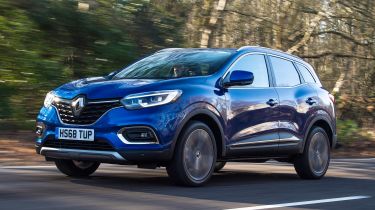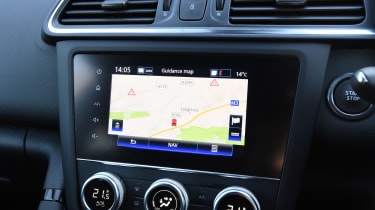Renault Kadjar (2015-2022) review - Interior, design and technology
Funky styling outside, though interior design looks a little bland compared to some rivals

The Renault Kadjar arguably has more character than the slightly generic Nissan Qashqai. Its big, bold nose with the massive Renault logo is very concept car-like, and the swept-back headlights make it immediately more striking to look at.
This is complemented by the curvaceous bodywork and panel creases that help give this tall vehicle a stylish swooping stance. Round the back, the modern design theme is maintained by some distinctive, shapely tail lamps. The Kadjar looks fine on the 17-inch alloy wheels, but it's the 19-inch diamond-cut wheels that really make the car stand out - as does the Flame Red metallic paint, which is one of eight available body colour choices.
Inside, apart from the digital instrument dials, the Kadjar doesn’t feel quite so futuristic – the layout is fairly functional, but rivals like the Peugeot 3008 and Skoda Karoq feel more special. Updates in 2018 improved things, though: the old car's fiddly air conditioning controls were replaced with big, simple rotating dials each inset with individual display screens, and the infotainment screen became integrated into the dashboard much more neatly. Overall quality is good, too, with soft-touch materials used in most places that you'll see while driving. Harder and more brittle plastics are used lower down in the car, but overall everything seems pretty robust and well put together.
Sat-nav, stereo and infotainment
The 2018 revisions introduced an infotainment setup that sits flush with the dashboard. It looks much neater than it did before, though some users might miss the physical volume controls. At least physical controls remain on the shortcut stalk on the steering column.
The R-Link 2 infotainment system itself isn't the best in the class. Loading times are a little slow, and the graphics looks rather fussy, which means at times it isn't as easy to use as rivals' setups. This is compounded by a screen which, measuring seven inches, is smaller than the best systems available. All but the entry level model get TomTom navigation though, which includes free traffic and map updates for the first 12 months after purchase. Addresses are easy enough to input, while traffic hold-ups are flagged up early.
Unlike the pre-facelift cars, all Kadjars now get both Apple CarPlay and Android Auto as standard. Connecting a smartphone via a USB cable or Bluetooth is straightforward, and both of these systems are superior to the in-built system in terms of graphics, loading times and mapping. The high-end S-Edition and GT Line models feature a solid-sounding Bose audio system, which features seven speakers and a separate subwoofer in the boot, but this means there's no option to add a space-saver spare wheel.










